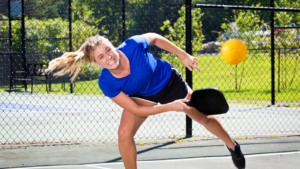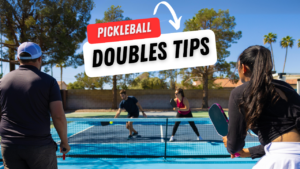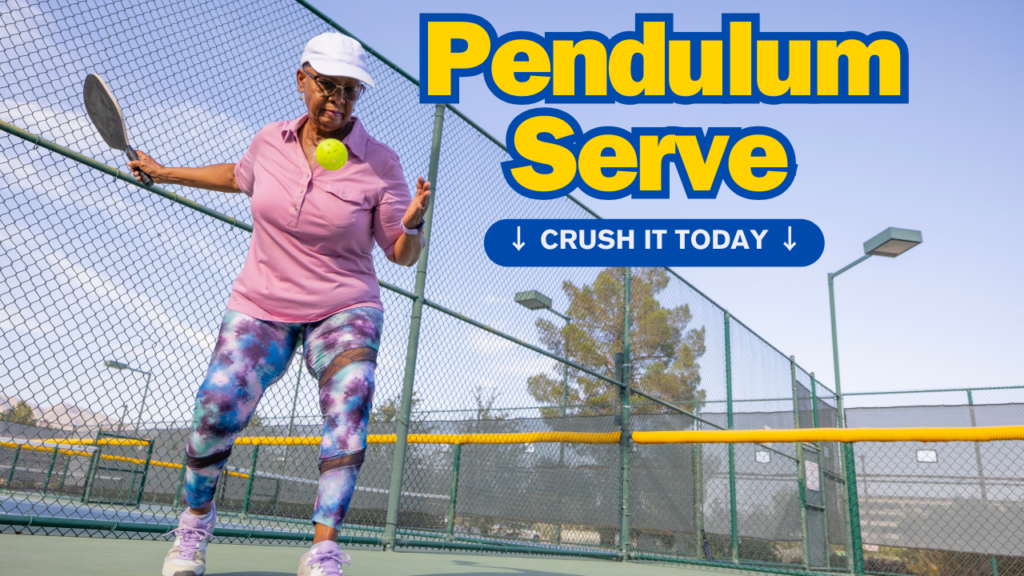
The pickleball pendulum serve is a game-changer. It combines power and precision, making it a must-know technique for all beginner players. Unlike traditional serves, this one adds a unique spin that keeps your opponents guessing. Mastering this serve can elevate your game and give you an edge on the court.
Many players struggle with consistency in their serves. The pendulum serve simplifies the process while enhancing your skills. With practice, you’ll find it easier to control the ball’s direction and speed using a forehand pendulum swing, proper weight transfer, and a consistent serve routine. This technique not only boosts your confidence with the forehand pendulum swing but also makes every match more exciting through a solid serve routine and effective weight transfer. Get ready to impress your friends and dominate the competition with this powerful serve using a pickleball pendulum serve.
Table of Contents
Key Takeaways
- Serving is very important in pickleball. A good serve, like a pendulum serve, can help you win points right away.
- The pendulum serve is a fun and effective way to serve. It uses a swinging motion to add spin.
- To do the pendulum serve, follow simple steps: start with your paddle low, swing it back, and then forward to hit the ball.
- While the pendulum serve has advantages, like being hard to return, it also has some downsides, like needing practice to master.
- Avoid common mistakes like hitting the ball too high or not following through with your swing.
- Practice with drills to improve your pendulum serve and make it a strong part of your game.
Importance of Serving in Pickleball
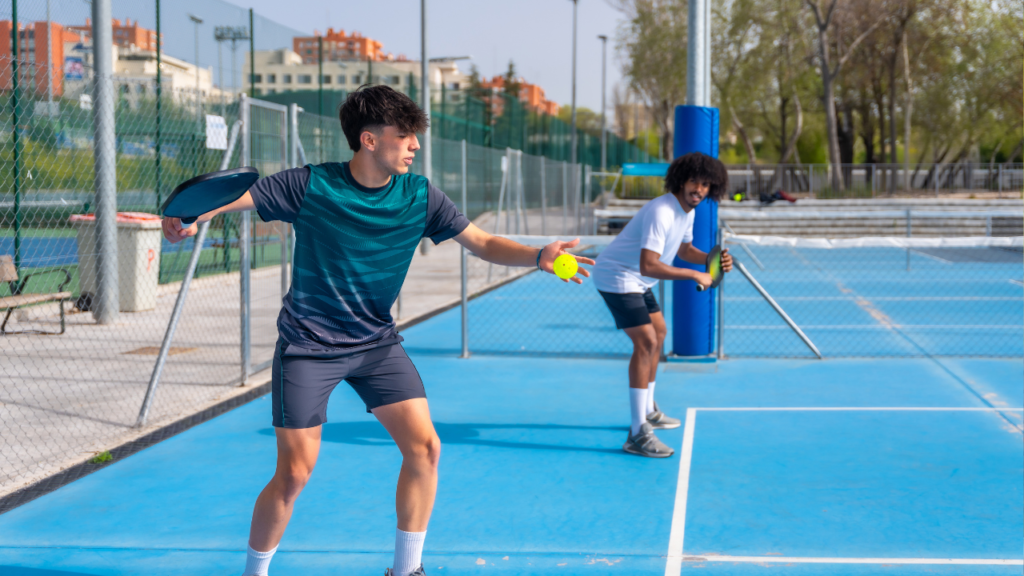
Critical Aspect
Serving is a key part of pickleball. It starts every point and sets the tone for the game. A good serve can surprise opponents. It makes them react quickly. This can lead to mistakes on their side.
A strong serve can also give players an advantage. They can control the game from the start. Players who serve well often win more points. They put pressure on their opponents right away. This pressure can make it hard for the other team to play their best.
Offensive Opportunities
A powerful serve opens up many offensive opportunities. When a player serves effectively, they can create chances to score points. For example, a fast serve can push opponents back. This gives the server space to attack.
Also, serving deep into the court forces opponents to move. They have to adjust their position quickly. A well-placed serve can even lead to an easy point if the opponent struggles to return it.
Mastering Various Serves
Players should learn different types of serves. Mastering various serves helps improve overall gameplay. Each type of serve brings unique advantages. For example, a pickleball pendulum serve adds spin and unpredictability.
Learning new serves allows players to adapt during matches. They can switch serves based on their opponent’s strengths and weaknesses. This flexibility keeps opponents guessing and off-balance.
Practicing different serves also builds confidence. Players feel more prepared when they know multiple techniques. This confidence shows during games and leads to better performance.
Strategy Enhancement
Serving is not just about power; it’s also about strategy. A smart player thinks about where to place the ball using a pickleball pendulum serve. They consider how the opponent will respond.
Using serves strategically can change the flow of the game. For instance, mixing up speeds and angles disrupts an opponent’s rhythm. A sudden change can catch them off guard.
Players should also focus on their positioning after serving. Getting ready for the next shot is important. Being in the right spot can lead to quick points after a strong serve.
Overview of the Pendulum Serve
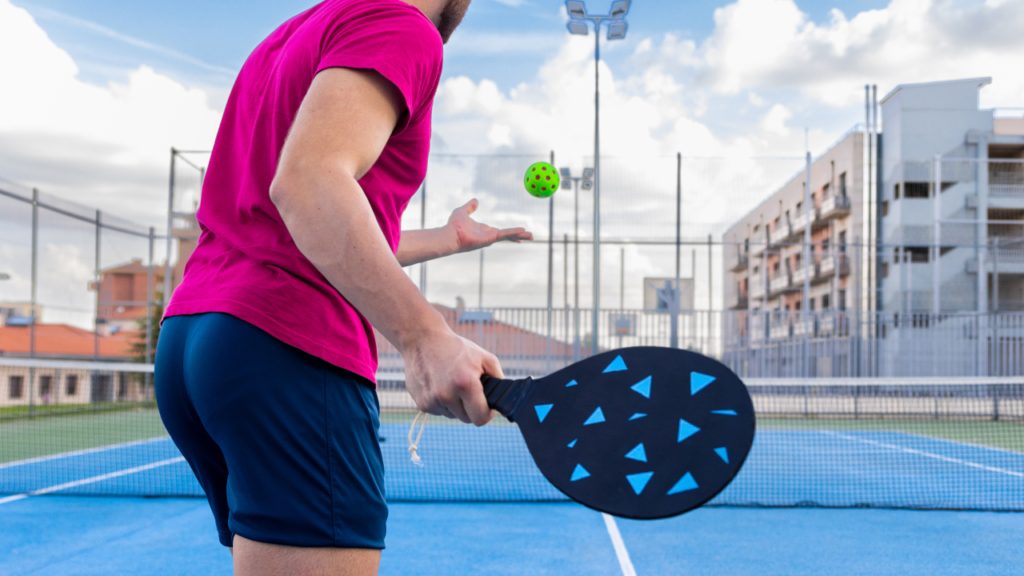
Definition
The pendulum serve is a special type of serve in pickleball. It uses a unique motion that differs from traditional serves. Instead of a straight arm swing, the pendulum serve involves a swinging action similar to a pendulum. The racket moves back and forth in an arc with a forehand pendulum swing. This motion creates a different angle and spin on the ball. Players can use this technique to surprise their opponents.
Weight Transfer
Weight transfer is very important for a successful pendulum serve. Players shift their weight from their back foot to their front foot during the swing. This movement helps generate power and control. Proper weight transfer allows players to execute a forehand pendulum swing and hit the ball with more force. It also improves accuracy. If players do not transfer their weight correctly during a pickleball pendulum serve, the serve may lack strength or direction.
Box Shape Concept
Another key element of the pendulum serve is the ‘box shape‘ in the racket arm. This concept refers to how the arm moves during the forehand pendulum swing serve. The racket should form a box-like shape as it swings back and forward. Keeping this box shape helps maintain control over the racket’s path during the forehand pendulum swing. It also ensures that players hit the ball at the right moment.
Steps to Execute the Pendulum Serve

Preparation Phase
Start by standing behind the baseline. Hold the paddle in your dominant hand. Position your feet shoulder-width apart. Bend your knees slightly for balance.
Next, place the ball in your non-dominant hand. Keep it steady at waist height. This position helps with control.
Swing Motion
Begin the swing by moving your paddle back. Shift your weight to your back foot. This is vital for generating power.
As you swing forward, shift your weight to your front foot. Timing is key here. A smooth transfer of weight, along with a forehand pendulum swing, will give the serve more strength.
Contact Point
Aim to make contact with the ball at waist height using a forehand pendulum swing. Your paddle should be angled slightly downwards. This angle helps send the ball over the net effectively.
Just before you hit the ball, flick your wrist upward. This final flick, with a forehand pendulum swing, adds spin and direction to the serve. The reverse pendulum motion is crucial here.
Follow-Through
After hitting the ball, follow through with your paddle. Let it finish high above your shoulder. This movement ensures a clean and controlled serve.
Watch where the ball goes after your serve. Adjustments can be made based on its flight path.
Practice Tips
Practice these steps regularly. Focus on timing and rhythm during each serve. Consider recording yourself to see where improvements can be made.
Here are some helpful tips:
- Start slow to understand the movements.
- Gradually increase your speed as you gain confidence.
- Pay attention to how others perform their serves.
Common Mistakes
Avoid common mistakes that can hinder your serve:
- Not transferring weight properly.
- Hitting the ball too low.
- Forgetting to follow through with the paddle.
By avoiding these errors, you’ll improve your pendulum serve quickly.
Pros and Cons of the Pendulum Serve
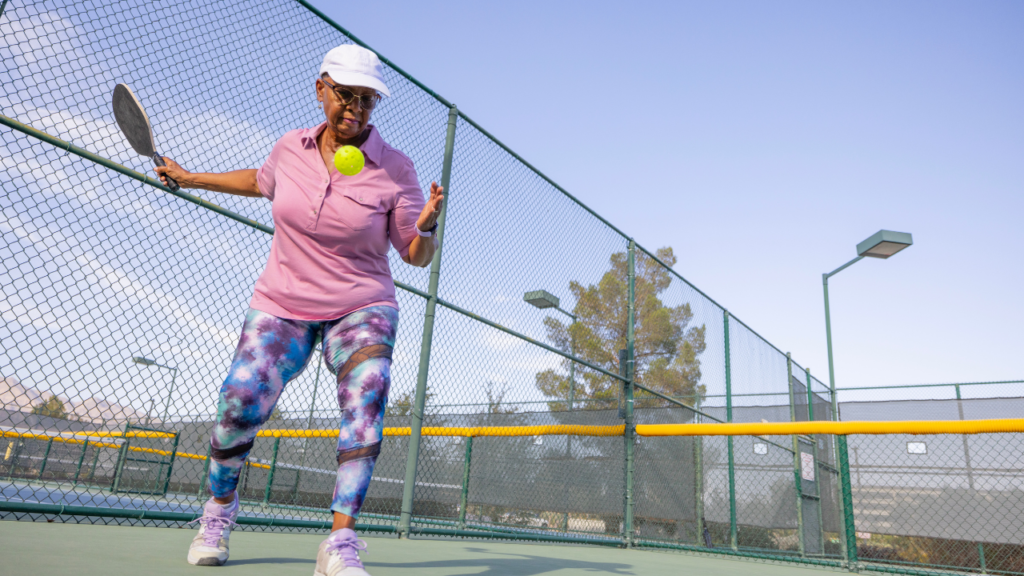
Advantages
The pendulum serve has several benefits. First, it creates unpredictability. Opponents may struggle to anticipate where the ball will go during a pickleball pendulum serve. The swing motion can confuse them. This serves as a strong tactic during matches.
Spin potential is another advantage. Players can generate significant spin using this technique. The rotation of the ball makes it bounce differently. This can lead to errors from the opponent. Many players find it hard to return a spinning ball effectively with a forehand pendulum swing.
Balance is also important in executing this serve. Proper leg positioning helps maintain stability. A good stance allows for better control over the ball’s direction. Strong balance leads to more accurate serves.
Drawbacks
Mastering the pendulum serve can be challenging. It requires practice and patience. Many beginners may find it hard to get right. The loose motion needed for the swing takes time to develop.
Players might also face issues with consistency. If the technique, including the forehand pendulum swing, is not perfected, the serve can become unreliable. Inconsistent serves can lead to easy points for opponents.
In some cases, players may overthink their execution. This can cause tension in their legs and body. Such tension disrupts flow and affects performance.
Playing Styles
The pendulum serve impacts different playing styles. Aggressive players benefit from its unpredictability. They can use it to keep opponents on their toes. This keeps pressure on them throughout the match.
Defensive players might find it less useful. They often rely on steady, predictable shots. The pendulum serve’s complexity may not fit their style well.
Match scenarios also play a role in effectiveness. In tight situations, a well-timed pendulum serve can surprise an opponent. However, in relaxed moments, simpler serves may work better.
Overall, players must evaluate their strengths and weaknesses, including their forehand pendulum swing, before choosing this serve.
Comparing the Pendulum Serve to Other Serve Styles

Flat Serve
Flat serves use a different technique. They require much arm motion and minimal backswing. Players hit the ball with speed and power. This serve travels straight and fast. It can catch opponents off guard.
The flat serve forces opponents to react quickly. They often need to adjust their court positioning. This may lead to mistakes if they are not prepared. However, flat serves can be predictable. Opponents may read them easily after a few tries.
Topspin Serve
Topspin serves have unique mechanics. They involve a strong upward swing and wrist action. The ball bounces higher due to the topspin. This makes it difficult for opponents to return.
Players using topspin serves benefit from added control. They can place the ball in tricky spots. Opponents must move quickly to respond. This often results in lateral movement across the court.
The topspin serve can be effective in longer rallies. It keeps the opponent on their toes but requires good timing and technique.
Pendulum Serve
Pendulum serves stand out because of their fluid motion. They rely on a smooth swing and wrist action. The player uses body weight for better balance during the serve.
This style allows for more control over placement. Players can aim for specific areas of the court. The pendulum serve also creates a unique spin that confuses opponents.
Opponents struggle with this serve due to its unpredictability. Unlike flat or topspin serves, it combines elements of both styles. It can be fast yet controlled, making it hard to anticipate.
Adaptability
Adaptability is crucial in pickleball. The pendulum serve shines in various game situations. Players can switch between power and finesse as needed.
Flat serves work well when aiming for quick points. However, they lack versatility against skilled opponents. Topspin serves are great for keeping players guessing but may become predictable.
Pendulum serves offer flexibility during matches. They allow players to change tactics easily based on their opponent’s weaknesses.
Common Mistakes to Avoid

Basic Techniques
Beginners often struggle with the basic techniques of the pickleball pendulum serve. One common mistake is improper weight transfer. Players should shift their weight from the back leg to the front leg during the serve. If they do not, it can lead to ineffective serves. This mistake makes it hard to generate power and control.
Another frequent error is using excessive arm motion. Moving the arm too much can disrupt the serve’s precision. A smooth, controlled swing is essential for a successful pendulum serve. Beginners should focus on keeping their arm relaxed and steady.
Positioning
Positioning plays a vital role in serving effectively. Many beginners stand too far from the baseline or too close to the net. Finding the right spot helps maintain balance and control during the serve. Proper positioning allows players to use their legs for power.
Players should also pay attention to their foot placement. The back leg should be firm while the front leg provides support. This stance helps create a stable base for the serve. Poor positioning can lead to mistakes and missed opportunities.
Back Leg and Front Leg
The back leg and front leg work together during the pendulum serve. Beginners often forget about this coordination. The back leg needs to stay strong as it supports the body’s weight. Meanwhile, the front leg should help push off when serving.
If players neglect this coordination, they may lose balance. Losing balance can result in wild serves that go out of bounds or into the net. Proper use of both legs ensures better control and accuracy.
Maintaining Control
Maintaining a correct box shape during the serve is crucial. A box shape means keeping your body aligned properly throughout the motion. Beginners sometimes let their bodies twist or turn too much during the serve. This can cause them to lose control over where the ball goes.
Keeping a steady posture helps focus energy on delivering a precise serve. Players should practice maintaining this box shape until it feels natural. It will improve their overall serving technique.
Practical Tips for Improving Your Serve
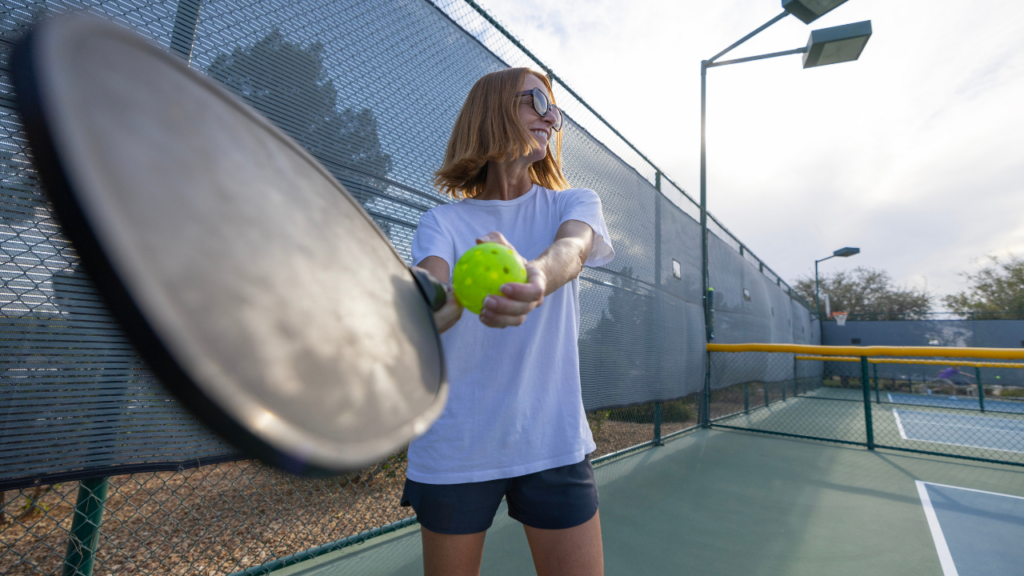
Consistent Practice
Focusing on consistent practice is key. Players should spend time refining their pendulum serve technique. Repetition helps build muscle memory. This makes the serve more reliable during games.
Start with a small backswing. This keeps the paddle under control. Use a smooth forward motion to strike the ball. Aim to keep your paddle hand steady. A strong backhand can also help improve your serve.
Practice serves in different directions. This adds variety and keeps opponents guessing. Try serving to the forehand side and then to the backhand side. Mixing it up makes your serve harder to predict.
Record Your Serves
Recording serves can be very helpful. Players can use a smartphone or camera to capture their form. Watching these videos helps identify areas for improvement.
Look for mistakes in foot placement and swing motion. Notice if the paddle is at the right angle when hitting the ball. This feedback is valuable for making adjustments.
Players can compare their serves to those of skilled players, like in USA Table Tennis competitions. Observing different styles offers new ideas for improving your own technique.
Seek Feedback
Seeking feedback from experienced players or coaches is important. They can provide insights that you may not notice yourself. Coaches often have tips based on years of experience in racquet sports.
Ask for advice on your serve routine. Experienced players can point out strengths and weaknesses in your technique. Their feedback can help refine both backhand shots and forehands.
Joining a local club can connect you with better players. Regular practice with them improves skills faster than practicing alone.
Develop a Serve Routine
Creating a personal serve routine helps build confidence. A routine sets a rhythm before each serve. It prepares the mind and body for action.
Include simple steps in your routine, such as bouncing the ball a few times or taking a deep breath. This helps calm nerves during competitive play.
Players should also focus on their paddle grip during this routine. A secure grip leads to better control over the ball’s direction.
Drills for Practicing the Pendulum Serve

Weight Transfer
To master the forehand pendulum swing, players should focus on weight transfer. Start with a basic drill. Stand with feet shoulder-width apart. Hold the paddle in your dominant hand. Shift your weight to your back foot as you prepare to serve. Then, step forward onto your front foot while swinging the paddle. This motion mimics the natural flow of a pendulum.
Practice this drill repeatedly. It helps develop muscle memory for proper weight transfer during serves. Use a mirror or video to check your form. Ensure your body moves smoothly and fluidly.
Wrist Flicking
Wrist flicking is crucial for a successful pendulum serve. A simple drill can help improve this technique. Hold a lightweight ball in your non-dominant hand. As you practice your swing, focus on snapping your wrist at the end of the motion. This flick adds speed and spin to your serve.
Another effective drill involves using a wall. Stand about 5-10 feet away from it. Practice serving against the wall, focusing on wrist movement. Aim for specific targets on the wall to improve accuracy.
Partner Drills
Practicing with a partner can simulate real game situations. One effective drill is called “Target Serve.” Set up cones or targets on the opposite side of the court. Take turns serving to these targets. This helps improve serve accuracy under pressure.
Another partner drill is “Return and Serve.” One player serves while the other returns. This creates a realistic environment where players can practice their serves and returns together. Players should switch roles frequently to balance practice time.
Solo Practice
Solo practice routines are essential for reinforcing serve mechanics. Begin with shadow swings without hitting a ball. Focus on creating the box shape with your paddle swing. Visualize how it should feel when hitting an actual serve.
Next, use a tennis ball or pickleball placed on a cone or small stand. Practice serving over it while maintaining proper form and technique. This helps reinforce your swing path.
Finally, set aside time for target practice alone. Place targets around the court and aim to hit them consistently with your serves. This builds confidence and precision in your serving skills.
Summary
Mastering the pickleball pendulum serve can elevate your pickleball game. This serve adds spin and unpredictability, making it tough for opponents to return. You’ve learned the steps, pros and cons, and common mistakes to avoid. Plus, you’ve got drills to sharpen your skills.
Now it’s time to put this knowledge into action. Practice regularly and focus on your technique. Share what you’ve learned with fellow players. The more you play, the better you’ll get. Embrace the pendulum serve and watch your game transform. Get out there and serve up some fun!
Frequently Asked Questions (FAQ)
A pendulum serve is a unique serving technique where the paddle swings like a pendulum, generating spin and speed. This serve can disrupt your opponent’s rhythm, making it harder for them to return.
Serving sets the tone for each point. A strong serve can give you an advantage by putting pressure on your opponent right from the start. It can also help dictate the pace of the game.
To execute a pendulum serve, hold the paddle low and swing it back and forth smoothly. Focus on generating spin by brushing up on the ball as you make contact. Practice will improve your consistency and accuracy.
The pendulum serve offers several benefits: it creates unpredictable spins, enhances ball placement, and can catch opponents off guard. This serve can lead to easier points and put pressure on your opponent.
Common mistakes include improper grip, inconsistent swing motion, and failing to follow through. These errors can lead to faults or weak serves that are easy for opponents to return.
The pendulum serve differs from other styles by focusing on spin and rhythm. While traditional serves prioritize power, the pendulum serves aim for precision and unpredictability, making it a strategic choice in gameplay.
Practice drills include shadow swings without the ball, serving against a wall, or using targets on the court. These exercises focus on improving your swing mechanics, accuracy, and spin generation for better performance.

